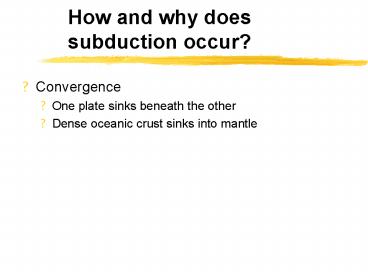How and why does subduction occur? - PowerPoint PPT Presentation
Title:
How and why does subduction occur?
Description:
Dense oceanic crust sinks into mantle. What and where is the Wadati-Benioff zone? ... Deformation intensifies in the core of the orogen (higher T and P) ... – PowerPoint PPT presentation
Number of Views:141
Avg rating:3.0/5.0
Title: How and why does subduction occur?
1
How and why does subduction occur?
- Convergence
- One plate sinks beneath the other
- Dense oceanic crust sinks into mantle
2
What and where is the Wadati-Benioff zone?
- Inclined array of earthquakes at subduction zone
- Correspond to upper edge of plate
3
How is magma produced at arcs?
- Water from subducting slab lowers the melting
point of overlying mantle - Note water also makes for explosive eruptions
4
Where and how do sediments accumulate in arc
environments?
- Sediments accumulate in accretionary wedges at
the trench - Two sources 1) volcanic arc 2) ocean sediments
5
Describe deformation of the sediment in the trench
- Bulldozer action scrapes ocean sediments and
thrusts material into a wedge
6
Briefly explain the orogenic cycle using India as
an example
- Gondwana rifts into pieces incuding India
- India diverges from antarctica but converges on
Asia - India sutures to Asia
7
How can continents accumulate additional terrain
via plate convergence?
- collage tectonics
- Example The berkshires
8
Have the continents always looked like they do
today?
- Continents have grown by lateral accretion
- Average age of continents 2 billion
- Average age of oceans 100 million
- Appalachian not at plate boundary
9
Has the mid-continent always been flat?
- Continental shield have the oldest rocks.
- Composed of sutured belts of mountains, which
were eroded to platforms long ago - These platforms have harbored shallow seas
10
What happens to the weak upper layers of crust
during collision?
- Compression results in thrust faulting and
folding into nappes. - Deformation intensifies in the core of the orogen
(higher T and P)
11
What happens to the weak upper layers of crust
during collision?
- Compression results in thrust faulting and
folding into nappes. - Deformation intensifies in the core of the orogen
(higher T and P)































